| Home | Rides | Reviews | Bikes | Gallery | Tech | Misc | Contact |
| Tips for Riding in Sand, Mud
and Snow by Martin Hackworth Photos: Martin Hackworth, MoJazz Staff |
|
|
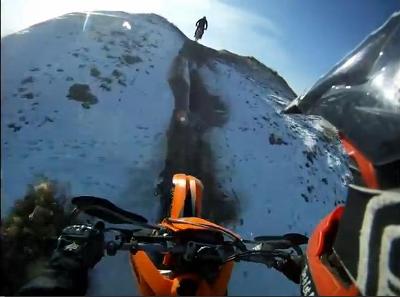 Sand, mud and snow - a trifecta. |
Sand,
mud and snow are often among the most
challenging conditions that dirt bike riders encounter. What follows
is a primer in techniques and skills we've found useful when
confronting soft, deep,
low-traction conditions. This isn't meant to be an
exhaustive treatise on riding technique (for that you'd need both more
gigabytes that we are going to use here and
some personal instruction - from
better than the likes of us), just a brief introduction to some things
to get you started. We'll concentrate on techniques applicable to reasonably light 4-stroke trail bikes: CRF450's, WR450's, etc. Larger, dual sport bikes (KLR650's, 950 Adventures, etc.) require different strategies for dealing with the loose stuff. Try dabbing a foot, for instance, to keep your BMW 1200GS moving in the right direction sometime and see what happens. Our best advice for those piloting heavy dual sports is to keep them on or close to dirt roads. Sand, snow and mud, at least in quantity, are generally the domain of dirt bikes. |
| The first things to think
about when sand,
mud and snow are on the menu are mechanical: tires, tire pressures,
suspension and
damper settings. We tend to favor stiff sidewall desert racing
tires (like the Dunlop
GeoMax MX51) because we can run them at
relatively low tire pressures (10-12 psi for desert races) without
worrying overly much about pinch flats. Others like softer, more
pliable tires (like Pirelli
Scorpions). In mixed
terrain, we are generally
happier with a harder compound tire over the long haul, just
for
the durability. Your mileage may vary. Try suspension damping settings slightly on the stiff side (both the front and rear) on all soft surfaces. Sandy trails tend to be whooped out, but the whoops tend to be big, round and spaced in such a manner as to allow the suspension adequate time to recover. Assuming proper setup to begin with, try going from the middle of the damping range to stiff one click at a time until you find what works best for you. Mud tends to weigh down your bike and will affect the "race sag" (loaded ride height) as it accumulates. Stiffer springs may be something to consider if you spend a lot of time in muddy terrain. |
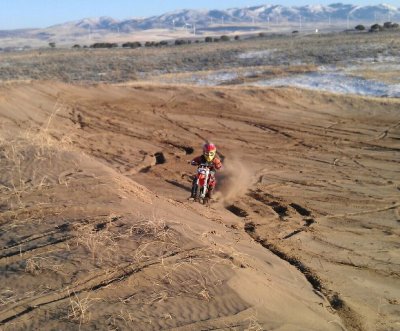 |
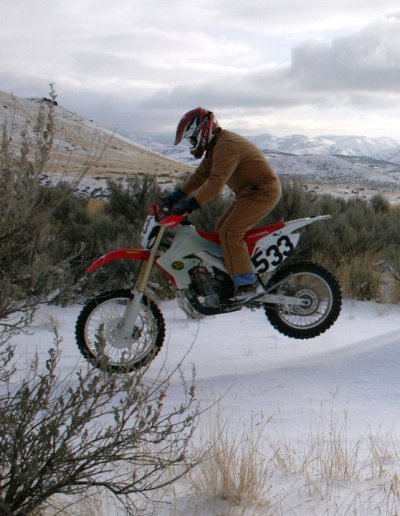 |
Unless we
are blazing over long
distances in a desert race we prefer to keep our steering
stabilizer in the low
end of its damping range - especially in
sand. Too much damping will
hinder a bike's ability to go where it wants to go in the loose and
wear you out in the
process. Along that line, about the
worst technique to
employ in sand and mud is to muscle the handlebars around like a
gorilla (more on this below). Excessive damping achieves
the same result, just mechanically. Like the old song goes, "hold on
loosely, but don't let
go." That goes for both you and your steering stabilizer. Nothing is more important in soft terrain than not overwhelming a bike's desire to float a bit with rigid steering inputs through the bars, the seat or the pegs. The very best way to accomplish this is to simply stand up. Try positioning the balls of your feet on the leading edges of the foot pegs - a position that results in a stance that seems to be the most relaxed and least tiring for general riding. You'll occasionally want to move forward or backward a bit, but return to center as quickly as possible to avoid fatigue. Though standing doesn't do a thing to effectively lower your center of mass (a common misstatement), it does make your pegs and bars the principal control inputs instead of your seat. It takes a little time, especially for noobs, to feel good about plowing into loose chop at full-tilt boogie while standing up. The ground seems mighty far away up there - especially with the bike bucking like a bronc! At first you will compensate by squeezing your grips with enough force to convert the carbon in them to low grade diamonds. But as soon as you learn to trust your suspension, stay centered, and to let the bike wander a bit while you stand and relax, you will find sand (and mud) much easier to handle. |
| As soon as you are comfortable standing and letting the bike run a little, it's time to learn which steering inputs are most effective when it is time to turn. A motorcycle in deep sand or mud has a mind of it's own about where it wants to go and you and it are frequently not on the same karmic plane. You must think less about steering and more about leaning. Do this by thinking less about steering with the bars and more about leaning with the footpegs in order to change direction. To accomplish this, try the following sequence: weight the inside peg to initiate lean, then square your hips and shoulders with the handlebars while transferring weight to the outside peg and pointing both your toes in the direction of the turn This movement pattern will move your bum to the outside of the turn, making it easy to drive your outside knee into the tank. Then, if necessary, get on the gas just enough to break loose the rear. It's also useful to look for terrain features, like ruts or berms, to sharpen the turn radius when available. Stay loose and centered then shake that booty like it's 1979, you are wearing a leisure suit and it's time to disco. | 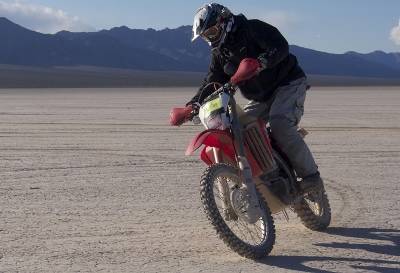 |
|
Once
you've got the basics
down and feel like you can make the bike go basically where you
want it's time to concentrate on being as smooth as possible.
A
common mistake in soft and loose terrain is getting too much weight
forward - something that kills momentum and makes intentional direction
changes difficult (as opposed to unintentional ones, which become very
easy). Getting too far forward tends to crop up as a problem
when riding
through whooped out or really deep sand. Try standing on the balls of
your feet and staying centered - then get on the gas! The more
aggressive
you are the easier it will be to keep your
weight back and the front end light. Experienced riders will often blip
the throttle in whoops to keep the front high while skimming
from
top to top. Don't worry about slowing down in soft terrain because it's
easier than you think - just let off the throttle! Speed is your friend in sand and mud (until it's not, that is, then it's really not your friend). The more things that are spinning the more stable the bike. Higher speeds also allow a bike to ride higher in the loose. A sandy wash that will wear you out at 2 mph will often be as casual as a jaunt down the interstate at around 20. Not only does spinning mass create its own unique form of stability (that tends to keep the bike moving in an easy straight line) but higher speeds allow a bike to ride on top of sand and mud instead of down in it. Just watch out for rocks hiding down there and whoops around corners. So far we've discussed sand and mud in the same general terms. But not all sand is the same, not all mud is the same and sand and mud are generally not the same at all. Coarse grain granitic sands (like that found in the Mojave) provide good buoyancy and traction and are generally good places to start. Fine grain basaltic sands (like those found in eastern Idaho) can be really difficult - especially after a prolonged dry spell. You'll need to be on your best game. |
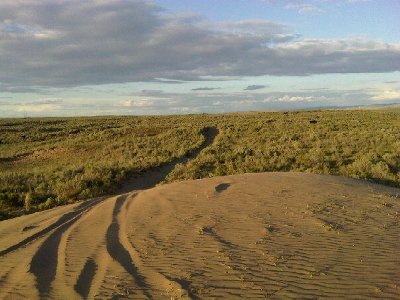 |
Mud
is
generally more difficult than
sand. There are some mud bogs we've encountered in MXGP races that
swallowed us whole before we could even yell for help (ask Cyril
Despres about how that works). The best advice
for mud, at least the deep variety, is to stay centered and
your speed up - just skim it! This requires nerves of steel and the
best way
to develop some is to find a muddy patch somewhere and practice until
you get the hang of it. The problem with really wet, deep mud is flotation (addressed with speed), the problem with deep viscous mud is ruts (nerves of steel). Sometimes the mud isn't either particularly deep or rutted - just slimy. Slime is the worst - especially slime mixed with rocks. It once took me 90 minutes to cover two miles along such a trail in the Owyhee Mountains in the spring. When you figure slime out, drop us a line. |
| When
things do go bad in mud
you can
take comfort in the fact that the landings are generally soft - unless
there is a boulder, a jeep, a dead animal or something else
either
hard or unpleasant buried down
there. Momentum is your friend - so keep up your speed and your faith
in the power of the force. If things go bad you can always rinse
yourself at the car wash along with your bike on the way home. Just be
sure to use only
the spot
free rinse setting on yourself unless you want to try out water jet
hair and scalp removal. Finally there is snow - something we get lots of around here. Riding in the snow is an absolute blast and not nearly as difficult as you might think - so long as it's not deeper than your skid plate is tall. In our experience snow's easier than sand and far easier than mud. Snow crystals tend to be kind of grabby and provide pretty good traction - better than you think. Ice is another matter: slick, treacherous, very hard to land on and really cold to lie on while waiting for the paramedics to arrive. |
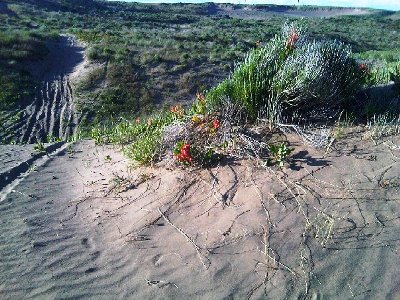 |
So easy a kid can do it! |
So there you go - our dearly
earned school-of-hard-knocks style tips for riding in sand, mud and
snow. Our pain is, hopefully, your gain. One more time around the track. Make sure that your bike is properly setup, stand up on the pegs, hang on loosely (but don't let go), use your feet, knees and hips to steer, keep your weight centered, stay on the throttle and move around to steer. Stay centered on the bike to avoid fatigue. Whoops are the biggest challenge in sand and you have to learn how to keep your speed up without getting launched into orbit (something that takes practice). With mud the problem is either too much water (bottomless), or too little water (ruts), or the perfect mix (slime). They all, pardon the pun, suck. Snow is way more fun than you'd think, just watch out for ice. |
| More
Video: Manix Wash (Mojave Road). More Tech Creek Crossings Reader Forum |
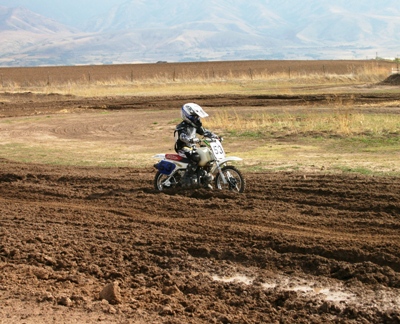 |
| Home | Rides | Reviews | Bikes | Gallery | Tech | Misc | Contact |
